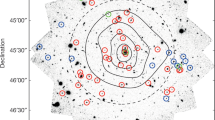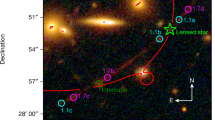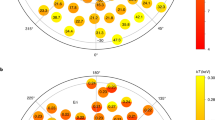Abstract
The abundance of metals in the hot, gaseous X-ray haloes of galaxy clusters depends crucially on the evolution of the constituent galaxies and their associated stellar populations. The metal abundances in X-ray clusters at high redshifts should therefore provide important insights into the nature and epoch of galaxyformation. Here we report the detection of an extended X-ray source in the direction of the lensed quasi-stellar object MG2016+112 (refs 1, 2). Although deep optical searches have failed to reveal a galaxy cluster at the lens position3,4, the X-ray emission is consistent with thermal bremsstrahlung radiation from a hot metal-rich, diffuse gaseous halo, as observed in nearby galaxy clusters. This is the most distant galaxy cluster discovered in X-rays so far. Furthermore, the mass of the cluster derived from this emission is consistent with that implied by lensing models of the system5. Given that the cluster apparently comprises few galaxies, yet contains a large amount of iron, a new type of astronomical object is implied by our results. A revision of theoretical models of the metal enrichment process in galaxy clusters may therefore be required.
This is a preview of subscription content, access via your institution
Access options
Subscribe to this journal
Receive 51 print issues and online access
$199.00 per year
only $3.90 per issue
Buy this article
- Purchase on Springer Link
- Instant access to full article PDF
Prices may be subject to local taxes which are calculated during checkout



Similar content being viewed by others
References
Lawrence, C. R. et al. Discovery of a new gravitational lens system. Science 223, 46–49 (1984).
Lawrence, C. R. in Astrophysical Applications of Gravitational Lensing (eds Kochanek, C. S. & Hewitt, J. N.) 299–304 (Springer, Berlin, (1995)).
Schneider, D. P. et al. Deep optical and radio observations of the gravitational lens system 2016+112. Astrophys. J. 294, 66–69 (1985).
Langston, G. I., Fischer, J. & Aspin, C. Infrared K-band observations of the gravitational lens 2016+112. Astron. J. 102, 1253–1257 (1991).
Narasimha, D., Subramanian, K. & Chitre, S. M. The gravitational lens system 2016+112 revised. Astrophys. J. 315, 434–439 (1987).
Schneider, D. P. et al. The third image, the redshift of the lens, and new components of the gravitational lens 2016+112. Astron. J. 91, 991–997 (1986).
Raymond, J. C. & Smith, B. W. Soft X-ray spectrum of a hot plasma. Astrophys. J. Suppl. Ser. 35, 419–439 (1977).
Anders, E. & Grevesse, N. Abundances of the elements — meteoritic and solar. Geochim. Cosmochim. Acta 53, 197–214 (1989).
Dickey, J. M. & Lockman, F. J. HI in the Galaxy. Annu. Rev. Astron. Astrophys. 28, 215–261 (1990).
David, L., Slyz, A., Jones, C., Forman, W. & Vrtilek, S. D. Acatalog of intracluster gas temperatures. Astrophys. J. 412, 479–488 (1993).
Tsuru, T. et al. in The 11th Int. Colloq. on UV and X-ray Spectroscopy of Astrophysical and Laboratory Plasmas (eds Watanabe, T. & Yamashita, K.) 375–378 (Universal Academy, Tokyo, (1996)).
Williams, O. R. et al. The X-ray spectra of high-luminosity active galactic nuclei observed by GINGA. Astrophys. J. 389, 157–178 (1992).
La Franca, F., Franceschini, A., Cristiani, S. & Vio, R. On the relationship between the optical and X-ray luminosities of quasars. Astron. Astrophys. 299, 19–24 (1995).
Gioia, I. M. & Luppino, G. A. The EMSS Catalog of X-ray selected clusters of galaxies. I. An atlas of CCD images of 41 distant clusters. Astrophys. J. Suppl. Ser. 94, 583–614 (1994).
Luppino, G. A. & Gioia, I. M. Constraints on cold dark matter theories from observations of massive X-ray-luminous clusters of galaxies at high redshift. Astrophys. J. 445, L77–L80 (1995).
Briel, U. G., Henry, J. P. & Böhringer, H. Observation of the Coma cluster of galaxies with ROSAT during the All-Sky Survey. Astron. Astrophys. 259, L31–L34 (1992).
Ohashi, T. in Proc. 17th Texas Symp. on Relativistic Astrophysics and Cosmology (eds Böhringer, H., Morfill, G. E. & Trümper, J. E.) 217–220 (New York Acad. Sci., New York, (1995)).
Donahue, M. Temperature and metallicity of a massive X-ray cluster at redshift 0.5. Astrophys. J. 468, 79–85 (1996).
Arnaud, M., Rothenflug, R., Boullade, O., Vigroux, L. & Vangioni-Flam, E. Some constraints on the origin of the iron enriched intra-cluster medium. Astron. Astrophys. 254, 49–64 (1992).
Hattori, M. & Terasawa, N. Metal enrichment of the intracluster medium from protogalaxies and the gamma-ray bursters. Astrophys. J. 406, L55–L58 (1993).
Ebeling, H., Mendes de Oliveira, C. & White, D. A. A2572 and HCG94 — galaxy clusters but not as we know them: an X-ray case study of optical misclassifications. Mon. Not. R. Astron. Soc. 277, 1006–1032 (1995).
Tanaka, Y., Inoue, H. & Holt, S. S. The X-ray astronomy satellite ASCA. Publ. Astron. Soc. Jpn 46, L37–L41 (1994).
Trümper, J. E. ROSAT. Phys. Scripta T7, 209–215 (1984).
Sarazin, C. L. X-ray emissions from clusters of galaxies. Rev. Mod. Phys. 58, 1–116 (1986).
Acknowledgements
We thank T. Sonobe, T. Miyaji, C. R. Lawrence, Y. Tanaka and M. Matsuoka for discussions. M.H. was supported in part by the post-doctoral program of the Max-Planck Gesellschaft and Yamada Science Foundation; Y.I. was supported by the Special Researchers' Basic Science Program of the Riken. H.B. and S.S. thank the Verbundforschung for support.
Author information
Authors and Affiliations
Corresponding author
Rights and permissions
About this article
Cite this article
Hattori, M., Ikebe, Y., Asaoka, I. et al. A dark cluster of galaxies at redshift z = 1. Nature 388, 146–148 (1997). https://doi.org/10.1038/40572
Received:
Accepted:
Issue Date:
DOI: https://doi.org/10.1038/40572
This article is cited by
-
How one galaxy can be a cluster
Nature (1997)
Comments
By submitting a comment you agree to abide by our Terms and Community Guidelines. If you find something abusive or that does not comply with our terms or guidelines please flag it as inappropriate.



